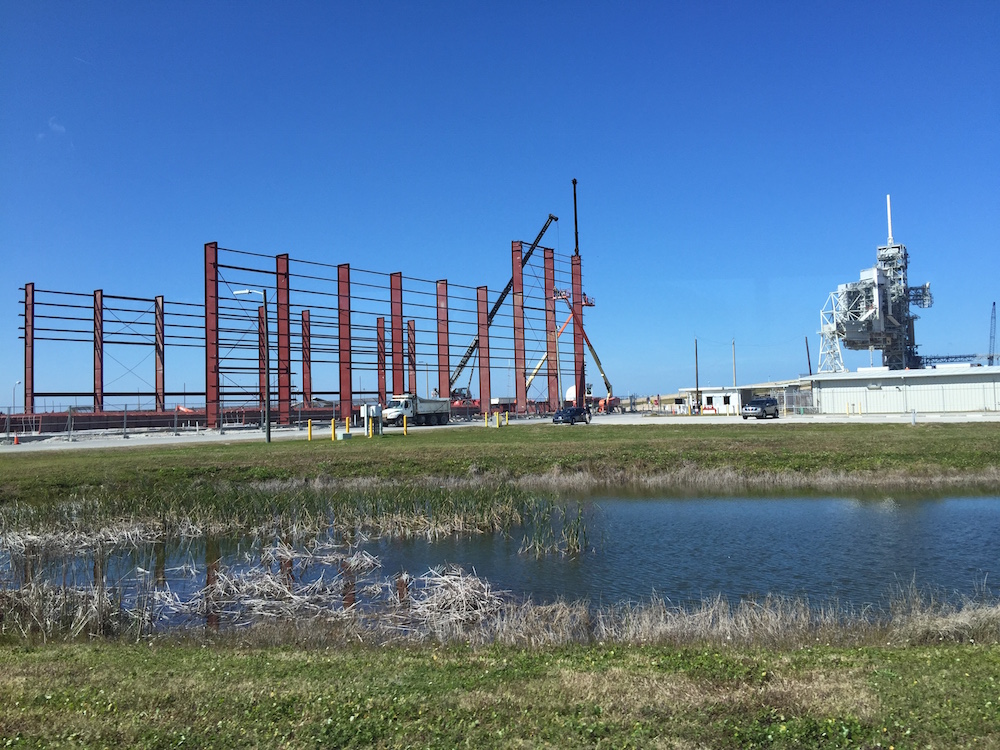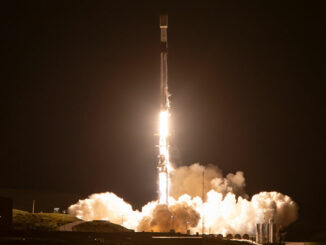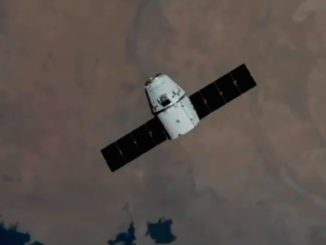
SpaceX began erecting a new hangar at a former space shuttle launch pad in Florida last week, moving the historic facility closer to launching astronauts again.
Positioned at the south perimeter of launch pad 39A, the hangar sits on the gravel crawlerway used to transport Saturn 5 moon rockets and space shuttles from the nearby Vehicle Assembly building to the launch pad.
SpaceX has no plans to use the mammoth VAB, the crawlerway or NASA’s huge diesel-powered crawler-transporters, which are being upgraded for the Space Launch System, an enormous government-owned launcher designed to take humans into deep space, and eventually Mars.
The rocket SpaceX plans to send up from launch pad 39A is not as big as NASA’s mega-rocket, but it will be the most powerful launcher flying when it debuts. The Falcon Heavy rocket, fitted with 28 kerosene-fueled engines, is scheduled for its first test launch in the second half of 2015.
After laying the building’s foundation, the Hawthorne, California-based space company started building the frame of the hangar last week, just as rivals Boeing and United Launch Alliance broke ground on a new access tower at the nearby Complex 41 launch pad.
Both facilities will launch astronauts on test flights of new commercial ferry capsules in 2017.
The hangar under construction on the south side of launch pad 39A will support assembly of SpaceX’s Falcon 9 rocket — already flying from Complex 40 a few miles to the south — and the new Falcon Heavy, which is made of three Falcon 9 booster cores bolted together.

The inaugural test launch of the Falcon Heavy will occur from pad 39A, marking the first liftoff from the seaside launch complex since the end of the space shuttle program in 2011.
Pad 39A was the starting point for all of the Apollo moon landing missions, plus the first and last launch of the space shuttle. In April 2014, SpaceX signed a 20-year lease for the launch complex with NASA, which retains ownership of the pad.
NASA is hanging on to launch pad 39B, the Kennedy Space Center’s other Apollo- and shuttle-era launch facility, to host SLS missions beginning in 2018.
Workers have installed ground storage tanks for the Falcon launcher’s rocket-grade kerosene fuel — called RP-1 — on the northeast edge of the launch pad. SpaceX plans to use the shuttle-era liquid oxygen tank sitting on the northwest side of the pad.
Construction crews are also working in the launch pad’s flame trench and will install rails leading up the ramp from the hangar to the Falcon rocket’s launch pedestal. The rails will be used to transport the rocket horizontally to the launch pad, where it will be rotated vertical.
Engineers will also fabricate a transporter-erector and strongback device for launch pad 39A.
SpaceX plans to add payloads to the Falcon 9 and Falcon Heavy rockets at pad 39A while they stand upright, a shift in the company’s operations concept at other launch facilities. At SpaceX’s current launch pads, technicians attach satellites and payload shrouds to rockets inside their hangars in a horizontal configuration.
The U.S. Air Force requires vertical payload integration for its most critical communications, navigation and spy satellites, a capability SpaceX will support once pad 39A is operational.
SpaceX hopes to compete to launch the Air Force’s most expensive missions as soon as this year, once the military certifies the Falcon 9 rocket. SpaceX will likely face a second round of certification for the Falcon Heavy rocket before it is eligible to launch the Pentagon’s heaviest payloads.
The first qualification booster for the Falcon Heavy rocket is now at SpaceX’s site in McGregor, Texas, for testing.
Astronauts will launch from pad 39A again aboard SpaceX’s Crew Dragon capsule.
SpaceX won a $2.6 billion contract from NASA in September for development, certification and flights of the Crew Dragon spacecraft beginning in 2017. Boeing’s CST-100 capsule is being designed to launch on ULA’s Atlas 5 rocket from the Complex 41 launch pad around the same time.
Follow Stephen Clark on Twitter: @StephenClark1.



